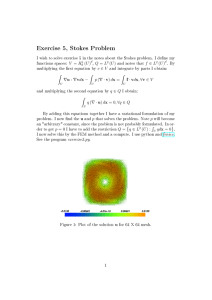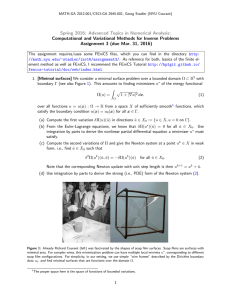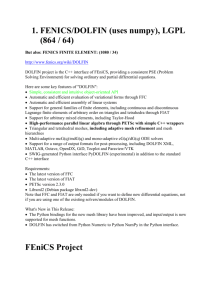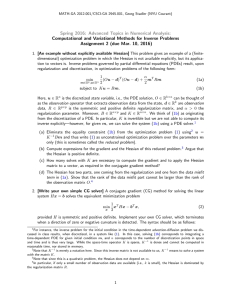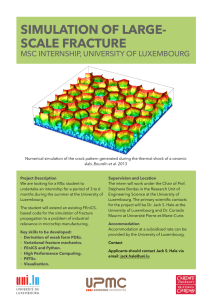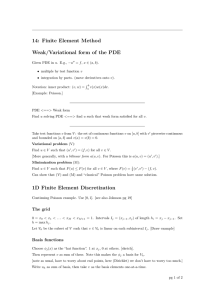FEniCS 1. FEniCS overview
advertisement
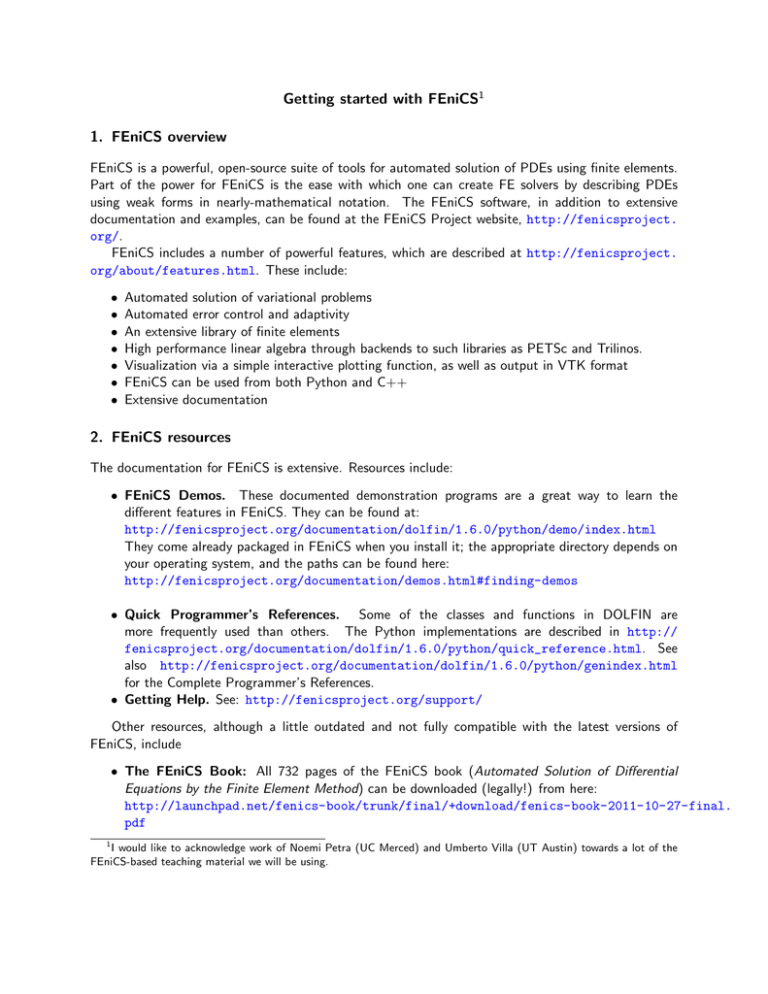
Getting started with FEniCS1 1. FEniCS overview FEniCS is a powerful, open-source suite of tools for automated solution of PDEs using finite elements. Part of the power for FEniCS is the ease with which one can create FE solvers by describing PDEs using weak forms in nearly-mathematical notation. The FEniCS software, in addition to extensive documentation and examples, can be found at the FEniCS Project website, http://fenicsproject. org/. FEniCS includes a number of powerful features, which are described at http://fenicsproject. org/about/features.html. These include: • • • • • • • Automated solution of variational problems Automated error control and adaptivity An extensive library of finite elements High performance linear algebra through backends to such libraries as PETSc and Trilinos. Visualization via a simple interactive plotting function, as well as output in VTK format FEniCS can be used from both Python and C++ Extensive documentation 2. FEniCS resources The documentation for FEniCS is extensive. Resources include: • FEniCS Demos. These documented demonstration programs are a great way to learn the different features in FEniCS. They can be found at: http://fenicsproject.org/documentation/dolfin/1.6.0/python/demo/index.html They come already packaged in FEniCS when you install it; the appropriate directory depends on your operating system, and the paths can be found here: http://fenicsproject.org/documentation/demos.html#finding-demos • Quick Programmer’s References. Some of the classes and functions in DOLFIN are more frequently used than others. The Python implementations are described in http:// fenicsproject.org/documentation/dolfin/1.6.0/python/quick_reference.html. See also http://fenicsproject.org/documentation/dolfin/1.6.0/python/genindex.html for the Complete Programmer’s References. • Getting Help. See: http://fenicsproject.org/support/ Other resources, although a little outdated and not fully compatible with the latest versions of FEniCS, include • The FEniCS Book: All 732 pages of the FEniCS book (Automated Solution of Differential Equations by the Finite Element Method) can be downloaded (legally!) from here: http://launchpad.net/fenics-book/trunk/final/+download/fenics-book-2011-10-27-final. pdf 1 I would like to acknowledge work of Noemi Petra (UC Merced) and Umberto Villa (UT Austin) towards a lot of the FEniCS-based teaching material we will be using. This is the comprehensive reference to FEniCS, along with many examples of the applications of FEniCS to problems in science and engineering. You will notice that the first chapter of the book is just the FEniCS Tutorial (with some minor editorial differences). • The FEniCS Manual. This is a 200-page excerpt from the FEniCS Book, including the FEniCS Tutorial, an introduction to the finite element method, and documentation of DOLFIN and UFL: http://launchpad.net/fenics-book/trunk/final/+download/fenics-manual-2011-10-31. pdf Since it’s an excerpt from the FEniCS Book, you probably won’t need it. 3. Installing FEniCS All of the Python codes for the examples and supporting materials for the exercises in this course require FEniCS version 1.6.0. The following steps will get you up and running with FEniCS on your system. • MacOS 10.9 and 10.10 systems:2 Download FEniCS 1.6.0 from http://fenicsproject.org/download/older_releases. html#older-releases. Find your MacOS version (either 10.9 or 10.10) and download the appropriate binaries of FEniCS 1.6.0. If you are running bash as default shell, you can add the following line to your .profile file in your home directory: source /Applications/FEniCS.app/Contents/Resources/share/fenics/fenics.conf Alternatively you can just double-click on the FEniCS icon in your Applications directory and that will generate a new shell preconfigured with the paths that FEniCS needs. Just run FEniCS from within this shell. FEniCS demo programs are located under /Applications/FEniCS.app/Contents/Resources/share/dolfin/demo • Ubuntu LTS 14.04:3 Open a shell and run the following commands: sudo sudo sudo sudo sudo sudo add-apt-repository ppa:fenics-packages/fenics-1.6.x apt-get update apt-get install -y fenics apt-get dist-upgrade apt-get install -y ipython-notebook apt-get install -y paraview NOTE: to minimize conflicts with other libraries already installed on your system it is suggested to start from a fresh installation of Ubuntu. If in the future you decide to uninstall FEniCS and remove all its dependencies, you can run the following commands: 2 If you have not done so yet, avoid upgrading to MacOS 10.11 (at least for now). FEniCS still does not fully support this version. 3 The same installation instructions may also work for different version of Ubuntu or other Debian-based versions of Linux. sudo apt-get purge --auto-remove fenics sudo ppa-purge ppa:fenics-packages/fenics-1.6.x FEniCS demo programs are located under /usr/share/dolfin/demo/ . • CIMS machines: Our CIMS machines are currently in the process of being moved from Red Hat Linux to CentOS. Computers in the student lab, and well as the compute servers snappy1--5 are currently already on CentOS. FEniCS can be installed on those (without root access), but before looking into details I would like to find out how many of you will want to rely on these machines versus their Laptops. To check the FEniCS installation on your system, go to the demo folder (see above for the exact location of this folder in your system) and run demo poisson.py by typing the following at the command lines: cd documented/poisson/python/ python demo poisson.py After compilation, you’ll get a message saying Solving linear variational problem. and a simple plot of the solution will pop up in a new window. If you mouse over the Help tag in the low left, you’ll get a list of some keyboard commands for interactive visualization. You can quit this run by typing q or Q. The Poisson equation code poisson demo.py is described extensively in the FEniCS Tutorial (pages 5–15), as well as online at http://fenicsproject.org/documentation/dolfin/1.6.0/python/demo/documented/poisson/ python/documentation.html
